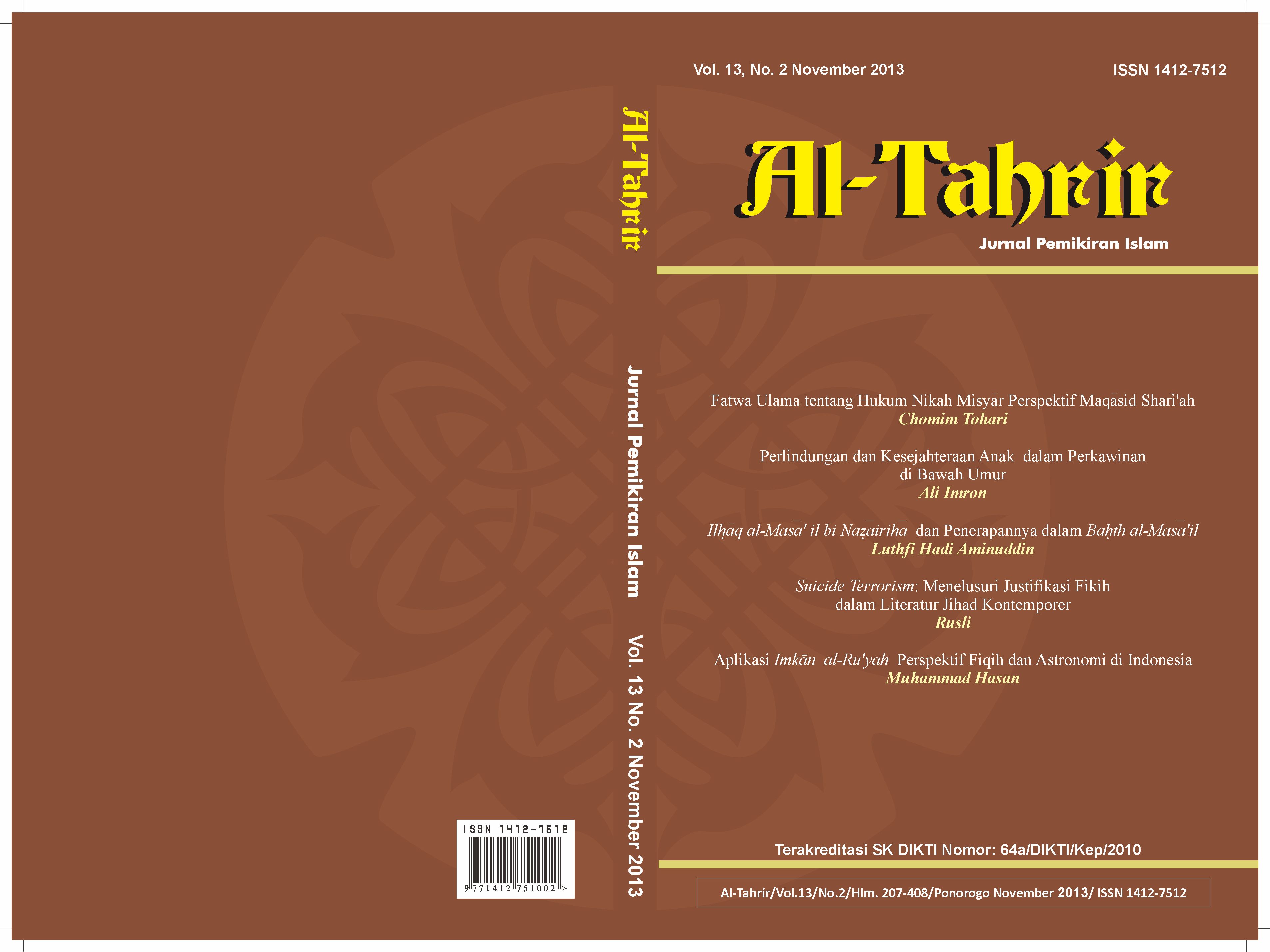Jilbab dalam Pandangan Muhammad Sa'id al-'Asmawi
DOI:
https://doi.org/10.21154/al-tahrir.v13i2.23Abstract
Abstract: Discussing the headscarf as a dress model in Islam is truely like talking about an outdated case because so many academics both from the West and the Islamic world itself has discussed it before. Yet, when confronted with the theoretical framework and approach or contemporary perspective, probably there is still academic space that can be used as a basis of analysis of long debate related to the jilbab, khima>r, muqna’, or clothing that are believed having value of shar’i> (Islamic laws). This paper attempts to explore, within its limitations, the concept of the veil/ headscarf through the thinking of Muh}ammad Sa’i> d al-’Asthma> wi> which are categorized by Wael B. Halla>q as a person in the area of liberal Islam. Through the theoretical framework of law, by using the historical approach of assets of jurisprudence ( us}u>l al-fiqh), al-’Asthma> wi>, the writer tries to position the concept of veil in Islamic teaching which is different from other islamic thinkers.Downloads
Downloads
Published
How to Cite
Issue
Section
License
Please find the rights and licenses in Al-Tahrir. By submitting the article/manuscript of the article, the author(s) agree with this policy. No specific document sign-off is required.
1. License
The non-commercial use of the article will be governed by the Creative Commons Attribution license as currently displayed on Creative Commons Attribution-NonCommercial 4.0 International License.
2. Author(s)' Warranties
The author warrants that the article is original, written by stated author(s), has not been published before, contains no unlawful statements, does not infringe the rights of others, is subject to copyright that is vested exclusively in the author and free of any third party rights, and that any necessary written permissions to quote from other sources have been obtained by the author(s).
3. User/Public Rights
Al-Tahrir's spirit is to disseminate articles published are as free as possible. Under the Creative Commons license, Al-Tahrir permits users to copy, distribute, display, and perform the work for non-commercial purposes only. Users will also need to attribute authors and Al-Tahrir on distributing works in the journal and other media of publications. Unless otherwise stated, the authors are public entities as soon as their articles got published.
4. Rights of Authors
Authors retain all their rights to the published works, such as (but not limited to) the following rights;
- Copyright and other proprietary rights relating to the article, such as patent rights,
- The right to use the substance of the article in own future works, including lectures and books,
- The right to reproduce the article for own purposes,
- The right to self-archive the article,
- The right to enter into separate, additional contractual arrangements for the non-exclusive distribution of the article's published version (e.g., post it to an institutional repository or publish it in a book), with an acknowledgment of its initial publication in this journal (Al-Tahrir).
5. Co-Authorship
If the article was jointly prepared by more than one author, any authors submitting the manuscript warrants that he/she has been authorized by all co-authors to be agreed on this copyright and license notice (agreement) on their behalf, and agrees to inform his/her co-authors of the terms of this policy. Al-Tahrir will not be held liable for anything that may arise due to the author(s) internal dispute. Al-Tahrir will only communicate with the corresponding author.
6. Royalties
Being an open accessed journal and disseminating articles for free under the Creative Commons license term mentioned, author(s) aware that Al-Tahrir entitles the author(s) to no royalties or other fees.
7. Miscellaneous
Al-Tahrir will publish the article (or have it published) in the journal if the article’s editorial process is successfully completed. Al-Tahrir's editors may modify the article to a style of punctuation, spelling, capitalization, referencing and usage that deems appropriate. The author acknowledges that the article may be published so that it will be publicly accessible and such access will be free of charge for the readers as mentioned in point 3.







